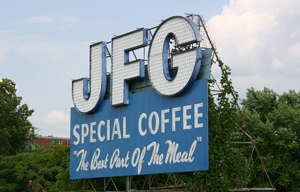Save or Demolish: How do we Decide which Local Structures are Historic?
The antebellum Sherrill House in west Knoxville teeters in serious disrepair after 20 years of neglect, but the structure will soon be saved. Plans for former Baptist Hospital, a riverfront landmark for decades, call for demolition to make way for new investment.

Photo: A recently refurbished JFG Coffee sign lights a hilltop on the south end of downtown.
Communities and cultural groups value older structures in very different ways. Some see highly prized historic resources while others see structures of little or no use. How do we decide which older buildings are worthy of preservation and which are not?
It boils down to deciding which buildings contribute to telling the story of our city to future generations.
To make that determination, there must be standards that serve as the foundation for a preservation policy. The Knoxville-Knox County Historic Zoning Commission adopted standards established by the National Park Service (NPS) to help determine whether a building is worthy of preservation. NPS standards are outlined below:
A historic structure is one that possesses three important characteristics:
- Sufficient age or "oldness"
- Physical integrity
- Significance
Age - Generally, a property must be at least 50 years old. Exceptions have been made for buildings that are important enough to be considered historic in terms of integrity or significance.
Integrity - A building with integrity has had few changes made to it, and its important architectural features are still in place.
Significance - A significant building has a story to tell. It can do so in one of three ways: by its association with people, events, or activities that have shaped history; by exhibiting a distinctive architectural style, method of construction, or fine craftsmanship with higher-quality materials; or, by providing a way of learning about the past through the study of its history or construction.
Care should be taken to preserve buildings which, at first glance, may not appear to have historical significance. Mansions and stately public buildings obviously tell the history of the rich and influential. But other buildings that may not be as old or as grand also have important stories of the past.
Modest bungalows of the 1940s were the homes provided to veterans after World War II. Textile mills and their surrounding "villages" reveal the bygone practice of industry providing housing for employees. Simple, two-story brick office buildings embody the frugality of small business owners struggling to survive the Great Depression. The homes, schools, shops, and workplaces of the working class should not be overlooked because of a short-sighted preference to protect the grandiose.
Sometimes more modern buildings, like those built between 1930 and 1960, are considered eyesores and unworthy of preservation. But a mix of buildings?old and new, simple and fancy?is needed to keep a city real and to define local character that may have taken centuries to develop.
Not every old building is worth preserving, but those that are need to be adapted to meet the needs of modern-day residents and businesses. A building can change and still remain connected to its past.
We cannot save them all, but the buildings we are able preserve will mark our local heritage for future generations, ensuring our city's history will not be lost.

